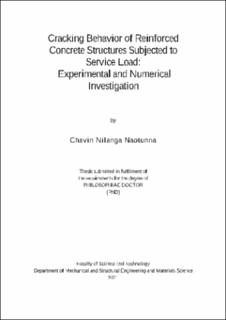Cracking Behavior of Reinforced Concrete Structures Subjected to Service Load: Experimental and Numerical Investigation
Doctoral thesis
Permanent lenke
https://hdl.handle.net/11250/2789578Utgivelsesdato
2021-10Metadata
Vis full innførselSamlinger
Originalversjon
Cracking Behavior of Reinforced Concrete Structures Subjected to Service Load: Experimental and Numerical Investigation by Chavin Nilanga Naotunna, Stavanger : University of Stavanger, 2021 (PhD thesis UiS, no. 606)Sammendrag
Cracks in reinforced concrete (RC) structures are controlled to enhance the service life, for a better aesthetic appearance, and to avoid leakages in liquid retaining structures. The most widely used crack controlling method at the structural design stage is to limit the calculated crack width to an allowable crack width limit. With an understanding of the economic and social benefits, there is a trend to build RC structures with a long service life. To enhance the durability of these structures, large concrete cover thicknesses are required to protect the embedded reinforcement from corrosion. These enhanced concrete cover thicknesses are larger than the limitations of existing crack width calculation models. From a literature survey and a parametric study conducted with the results from recent experiments in the literature, it can be identified that the existing crack width calculation models require improvement, to predict the crack widths in RC specimens with large concrete cover thicknesses.
The next objective is to study the different theoretical approaches discussed in the literature regarding the approaches to cracking and to identify the most relevant method for the actual cracking behavior in RC members subjected to service load. To achieve this objective, an experimental program was conducted to test large-scale RC specimens in axial tension. Then it was identified that the actual cracking behavior in RC members with ribbed reinforcement is more related to the ‘no-slip approach’ (perfect bond between reinforcement and concrete) than the classical bond-slip approach. This finding has been further confirmed with a literature survey focused on the previous experimental studies that measured the slip between the reinforcement-concrete interface.
After studying the ‘no-slip approach’, an experimental program was conducted to investigate the governing parameters for crack spacing. From the experimental program, it was identified that both concrete cover thickness and the clear distance between bars have an influence on crack spacings and therefore on the crack widths in RC specimens. Then, with the results of the conducted experiments and the results of a series of calibrated 3D non-linear finite element method simulations, an improved crack spacing model was developed, to predict the crack spacings in RC members with multiple bars that are subjected to axial tension. The crack width variation along the large concrete cover thickness has been studied by means of an experimental program. From this study, it was found that the effect of shear lag has an influence on the surface crack widths of RC members. Based on the findings, an improved crack width calculation model has been proposed, and its predictions gave good agreement with the experimental results in recent literature.
Beskrivelse
PhD thesis in Mechanical and Structural Engineering and Materials Science
Består av
Paper 1: Naotunna, C.N., Samarakoon, S.M.S.M.K., and Fosså, K.T. (2019). Comparison of the behavior of crack width governing parameters with existing models. International Conference on Sustainable Materials, Systems and Structures (SMSS 2019). Rovinj: pp. 124- 131, ISBN: 978-2-35158-226-8, ISSN: 1333-9095. This paper is not included in Brage for copyright reasons.Paper 2: Naotunna, C.N., Samarakoon, S.M.S.M.K., and Fosså, K.T. (2021). Applicability of existing crack controlling criteria for structures with large concrete cover thickness. The Journal of Nordic Concrete Research, pp. 69-91, DOI: 10.2478/ncr-2021-0002.
Paper 3: Naotunna, C.N., Samarakoon, S.M.S.M.K., and Fosså, K.T. (2020). Experimental and theoretical behavior of crack spacing of specimens subjected to axial tension and bending. The Journal of Structural Concrete, pp. 775-791, DOI: 10.1002/suco.201900587.
Paper 4: Naotunna, C.N., Samarakoon, S.M.S.M.K., and Fosså, K.T. (2020). Identification of the influence of concrete cover thickness and ∅/ρ parameter on crack spacing. The 15th International Conference on Durability of Building Materials and Components (DBMC 2020). Barcelona: pp.1797-1804, ISBN: 978-84-121101-8-0.
Paper 5: Naotunna, C.N., Samarakoon, S.M.S.M.K., and Fosså, K.T. (2021). Influence of concrete cover thickness and clear distance between tensile bars on crack spacing behavior: Experimental and numerical investigation. (Submitted to journal).
Paper 6: Naotunna, C.N., Samarakoon, S.M.S.M.K., and Fosså, K.T. (2021). A new crack spacing model for reinforced concrete specimens with multiple bars subjected to axial tension using 3D non-linear FEM simulations. The Journal of Structural Concrete (Accepted to publish).
Paper 7: Naotunna, C.N., Samarakoon, S.M.S.M.K., and Fosså, K.T. (2021). Experimental investigation of crack width variation along the concrete cover depth in reinforced concrete specimens with ribbed bars and smooth bars. The Journal of Case Studies in Construction Materials. DOI: 10.1016/j.cscm.2021.e00593.
Utgiver
University of Stavanger, NorwaySerie
PhD thesis UiS;;606
